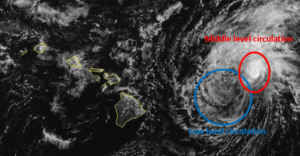Tropical Cyclone Asna was spinning over the Arabian Sea south of Pakistan on Saturday. At 5:00 p.m. EDT on Saturday the center of Tropical Cyclone Asna was located at latitude 23.2°N and longitude 62.9°E which put the center about 275 miles (445 km) west-southwest of Karachi, Pakistan. Asna was moving toward the west at 9 m.p.h. (15 km/h). The maximum sustained wind speed was 50 m.p.h. (80 km/h) and there were wind gusts to 65 m.p.h. (105 km/h). The minimum surface pressure was 989 mb.
Tropical Cyclone Asna strengthened on Saturday as it moved across the northern Arabian Sea south of Pakistan. The inner end of a rainband wrapped around the western and southern side of the center of Tropical Cyclone Asna. Thunderstorms were occurring in bands in the northern and western parts of Asna’s circulation. Bands in the southeastern part of Asna consisted primarily of showers and lower clouds. Storms near the center of Asna’s circulation generated upper level divergence that pumped mass away to the west of the tropical cyclone.
Winds to tropical storm force extended out 100 miles (160 km) from the center of Tropical Cyclone Asna.
Tropical Cyclone Asna will move through an environment somewhat favorable for intensification during the next 24 hours. Asna will move over water where the Sea Surface Temperatures are near 28°C. It will move through a region where the upper level winds are weak and there will be little vertical wind shear. There is a large mass of drier air over Southwest Asia. The circulation around the northern side of Asna could draw drier air into the tropical cyclone. Tropical Cyclone Asna could strengthen a little more during the next 24 hours, if Asna does not pull too much drier air into its circulation.
Tropical Cyclone Asna will move around the southeastern part of a high pressure system over Southwest Asia. The high pressure system will steer Asna toward the west during the next 24 hours. On its anticipated track, Tropical Cyclone Asna will move toward Oman.

